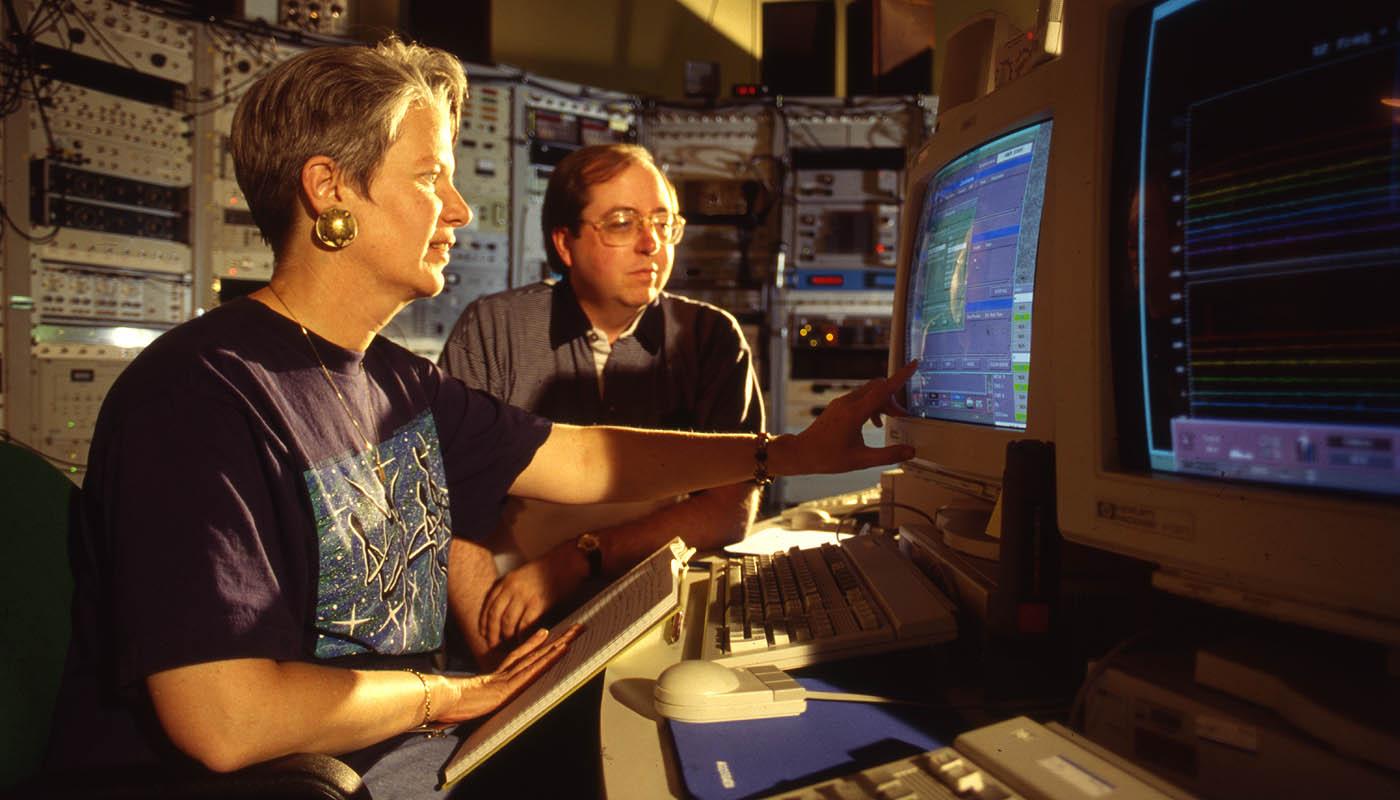
What is SETI?
SETI is a generic acronym that stands for the Search for Extraterrestrial Intelligence. Scientists doing SETI experiments are looking for proof – not merely of life elsewhere – but of intelligent beings in other star systems.
The SETI Institute
The SETI Institute was brought to life on November 20, 1984, when San Francisco State’s Director of Research, Tom Pierson, traveled to Sacramento, California to deliver the paperwork necessary to found a new non-profit corporation. At the time, there was only one project in the Institute’s portfolio: a radio search for signals that would prove the existence of other intelligence in the cosmos. This effort was headed by a young astronomer and Cornell graduate, Jill Tarter. Pierson became the new Institute’s CEO.

This project became known as the NASA SETI Program (later renamed the NASA Microwave Observing Project) which, at its peak in the early 1990s, was granted as much as $10 million annually to design and build equipment that could be used to pursue the hunt for signals. By the fall of 1992, that equipment was operational, and the “listening” began. Lamentably, a year later a Senate initiative by congressman Richard Bryan of Nevada killed NASA’s SETI activities, and the Institute’s hunt for signals has been overwhelmingly dependent on funding from individuals and private organizations ever since.
A brief description of the science of the search for extraterrestrial intelligence, as well as the Institute’s observing programs, is given below.
How is it done?
Scientists long ago realized that we can’t find aliens by climbing into rockets and zipping off to other planetary systems. Such galactic galivanting is standard fare in movies and on television, a circumstance that has convinced many people that it’s something humans will be doing real soon now. But the enormous distances to the stars (even the nearest is 7,000 times farther than Pluto) means that we simply aren’t about to visit the aliens. Warp drive is a lovely idea, but no more than that.
And while some people think that the extraterrestrials, with their advanced technology, may be able to come here, this is not a popular idea among most scientists.
Consequently, most SETI these days eschews rockets, and relies on radio telescopes – massive antennas outfitted with highly sensitive and specialized receivers. The idea is simple: Forget the rockets and bring on the photons. Let signals beamed via radio (or light) do the traveling.
Radio is a great way to send information over the incredible distances between the stars; it easily passes through the dust and gas that suffuse space, and it does so at the speed of light (about 20,000 times faster than our best rockets.)
The idea that signals might be clues to the existence of technically advanced societies is an old one. In the 19th century, there were several proposed schemes to communicate with Martians by using mirrors and lamps or by constructing large geometric patterns in forests or deserts.
By 1900, the new technology of radio was being considered as a better means to get in touch across the vast reaches of space. Nikola Tesla was convinced that strange signals picked up by his massive transmitter tower in Colorado Springs, Colorado, were broadcasts from Mars. A few years later Guglielmo Marconi similarly claimed to have received transmissions from the fourth rock from the Sun.
In retrospect, we know that these were not hailing attempts by Red Planet inhabitants. One possibility is that they were “whistlers” – low-frequency radio waves produced by lightning that propagates through Earth’s magnetosphere. In general, the low-frequency radio equipment of the early part of the twentieth century would have been unsuitable for picking up extraterrestrial broadcasts, simply because transmissions at these wavelengths are heavily “bent” (refracted) by the ionosphere. On the one hand, this is a boon to folks trying to tune in distant AM stations at night when the ionosphere becomes particularly effective as a radio mirror. However, this atmospheric behavior can also screen out much of the low-frequency radio emissions from the cosmos, including any possible alien broadcasts.
After the Second World War, it became apparent that the best radio wavelengths to use for anyone trying to communicate over light-years of distance would be microwaves (centimeter wavelengths.) To begin with, this part of the radio band is relatively quiet – it is largely free of the lower frequency hiss caused by high-speed interstellar electrons pirouetting through the magnetic fields of the Milky Way. Second, microwave signals pass unhindered through the gas and dust that floats between the stars.

A consensus emerged that a preferred range of frequencies for interstellar communication was 1420 to 1666 MHz (wavelengths of 18 to 21 cm). These two frequencies correspond respectively to the natural emission frequencies of neutral hydrogen and the hydroxyl radical, both of which are found in space in large quantities. Bernard (Barney) Oliver, an engineer and polymath who became the architect for much of the original NASA SETI program, took note of the fact that hydrogen (H) and the hydroxyl radical (OH), when combined, form water – an ingredient that many consider to be the sine qua non of life. He dubbed the wavelength range from 18 to 21 cm the “water hole” – a place where various forms of life gather. It has remained a favored part of the radio dial for SETI experiments.
A major breakthrough for SETI took place in 1959. In that year, a pair of Cornell physicists, Philip Morrison and Giuseppe Cocconi, considered a simple thought experiment: If you were to separate two antennas that faced one another – one outfitted with a powerful radar transmitter, and the other with a sensitive radar receiver – what’s the maximum distance at which the transmission could still be successfully received? An elementary calculation revealed that the distance was many light-years.
It had been merely a half-century after the invention of practical radio, but Morrison and Cocconi realized that humanity already had in hand technology that could be used to communicate between star systems. If we could do this, surely there were advanced cosmic societies with similar or greater ability. The skies could be filled with alien radio communications. All that was necessary to find them was to look. They published their findings in a classic paper in the journal Nature.

The First Modern SETI Experiment
The first technically sophisticated attempt to actually discover radio communications from beyond Earth was Project Ozma, a several month effort by a young radio astronomer, Frank Drake. Although unaware of the Nature paper published a year earlier, Drake had come to conclusions similar to those of Morrison and Cocconi. In the spring of 1960, he used an 85-foot diameter antenna (the Howard Tatel telescope) at the National Radio Astronomy Observatory in Green Bank, West Virginia to seek microwave transmissions from planets that might be orbiting two nearby stars, Epsilon Eridani (10 light-years distant) and Tau Ceti (12 light-years). This was before the discovery of so-called “exoplanets” – planets orbiting other stars, but Drake made the assumption that planets were probably very common.
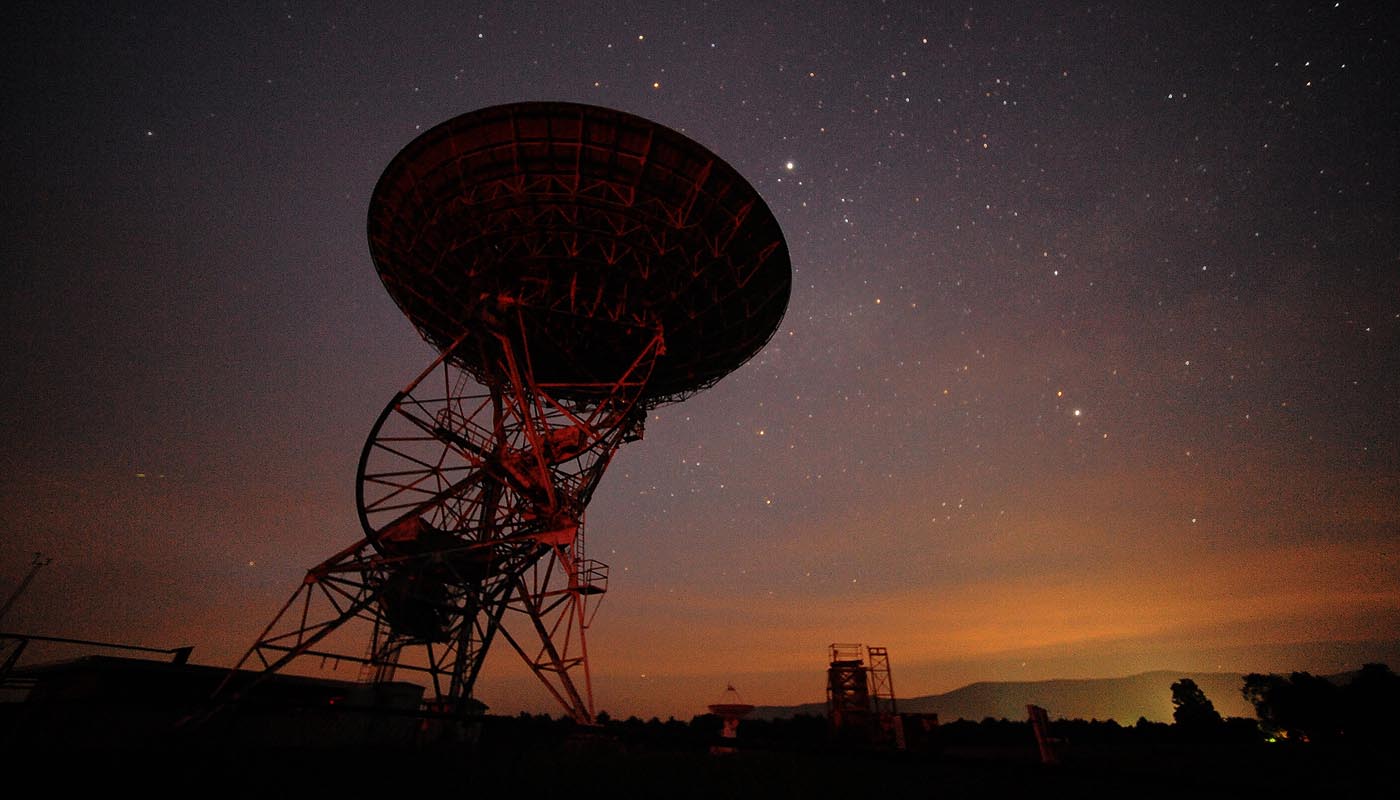
Sequentially pointing the antenna towards first one and then the other of these nearby Sun-like stars, he tuned an existing NRAO receiver to the 21 cm band, slowly dialing it up and down in frequency while listening to the output on the receiver’s loudspeaker. Although he was briefly buoyed by some terrestrial interference (he thought “could it be this easy?”), Drake detected no compelling evidence of cosmic signaling. His experiment, which he named Project Ozma, was the forerunner of all of today’s SETI searches.
The Drake Equation
Following the widespread interest generated by Project Ozma, the National Academy of Sciences encouraged Drake to arrange a short meeting in Green Bank to discuss the fundamental likelihood of other intelligence in the universe. Eleven eminent scientists attended, and as an agenda for this gathering Drake composed a simple equation. It was a concatenation of the factors he thought essential to the emergence of a technically competent species – terms such as the probability of life developing on an Earth-like planet, the average lifetime of a species able to engineer radio communication, etc.
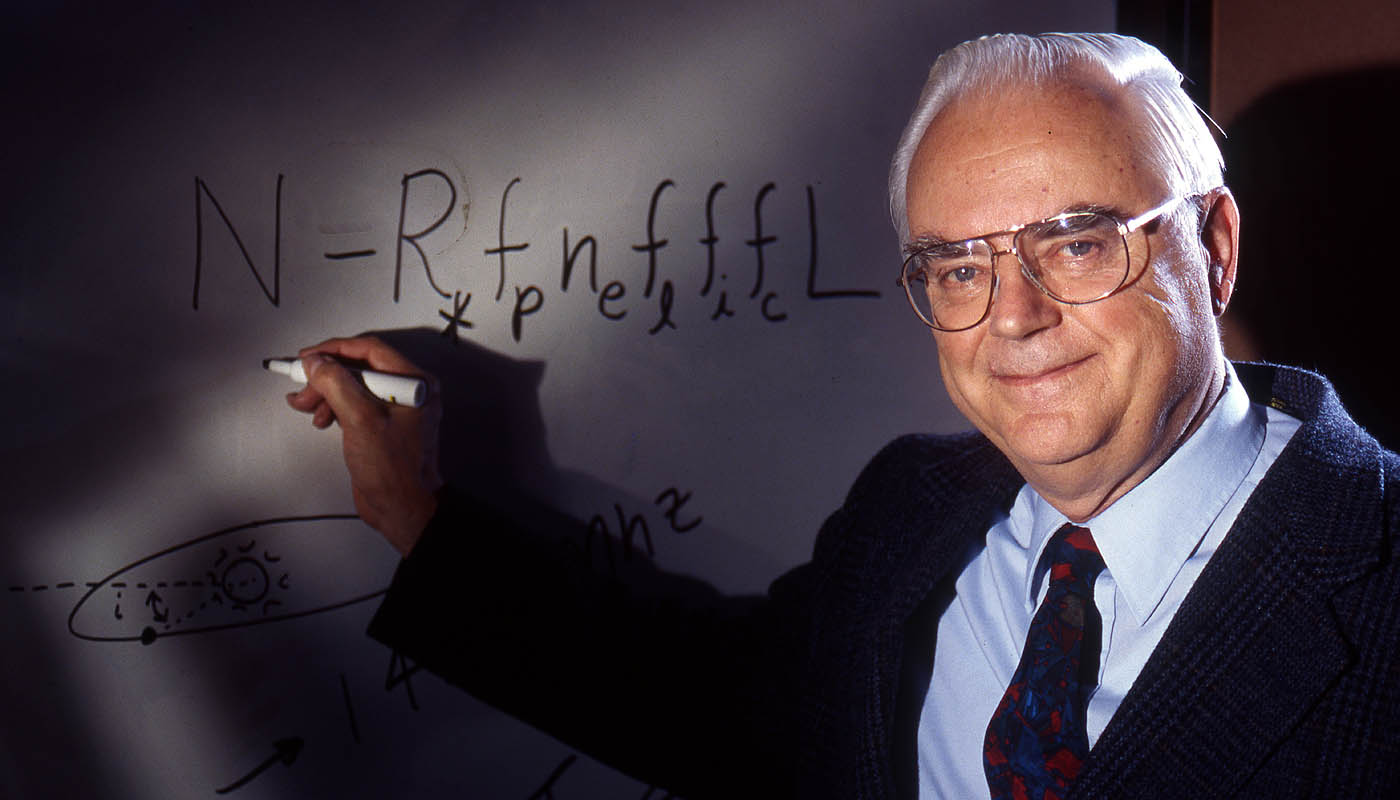
While the Drake Equation, as the formula is known, is of great utility in discussing the circumstances necessary to spawn and sustain intelligence, only a few of its factors are well known. It is said that the Drake Equation – which is discussed in virtually every introductory astronomy textbook – is the second-most famous formula in science, after E=mc2.
Project Phoenix
Project Ozma was followed by dozens of informal SETI efforts, mostly conducted by astronomers who – during breaks in their research programs – would use radio telescopes at their disposal to examine nearby stellar systems and sometimes entire galaxies. They hoped to find a signal that would change the world.
At this time, the majority of SETI activity – both theoretical and observational – was in the United States and the Soviet Union. In Europe, only Italy expended notable effort on this problem. Even today, rather few countries have energetic SETI searches underway. The explanation for this lies partially with the difficulty of finding funding, but there is also a cultural component. The total number of scientists and engineers engaged in SETI activities full-time is roughly two dozen, world-wide.

As noted earlier, the NASA SETI Program, which initiated its two-pronged approach to scrutinizing the sky for signals, began observations using the 1,000-foot diameter radio telescope at Arecibo, Puerto Rico, and the NASA Goldstone 70-meter antenna. But the program was ended within a year after it’s start by the U.S. Congress. Following this abrupt termination, the staff of the SETI Institute understood that it could continue the search only by finding private funding. Barney Oliver quickly contacted four of his personal friends in the hi-tech arena – Bill Hewlett, David Packard, Gordon Moore, and Paul Allen – to solicit their support. Each agreed to contribute a million dollars annually over a five-year period.
With funding secured, the Institute could continue with one part of the planned NASA program, the so-called Targeted Search. The intention was to examine specific targets – the vicinities of nearby Sun-like stars – using large radio telescopes. The other half of the original NASA SETI project, the all-sky survey, had to be dropped.
The resuscitated targeted search was dubbed Project Phoenix, referencing the bird of Greek mythology that periodically rose from the ashes of its predecessor.
Project Phoenix’s goal was to scrutinize approximately one thousand star systems. Its receiver system, which made use of much of the equipment developed for the NASA SETI program, could monitor 10 million 1 Hz-wide channels at a time.
Project Phoenix’s first observations took place in February, 1995, using the Parkes 64-meter antenna in the sheep country west of Sydney, Australia. About 200 star systems, only visible in the southern hemisphere, were examined. In the fall of 1996, the Project Phoenix receivers – an elaborate system of electronics packaged in a shipping container – were moved to Green Bank, West Virginia. The 140-foot diameter radio telescope at that site was used to continue the targeted search of star systems in the northern hemisphere for two years. In the fall of 1998, the equipment was again moved, to the Arecibo 1,000-foot antenna in Puerto Rico. The project ended in the early 2000s.
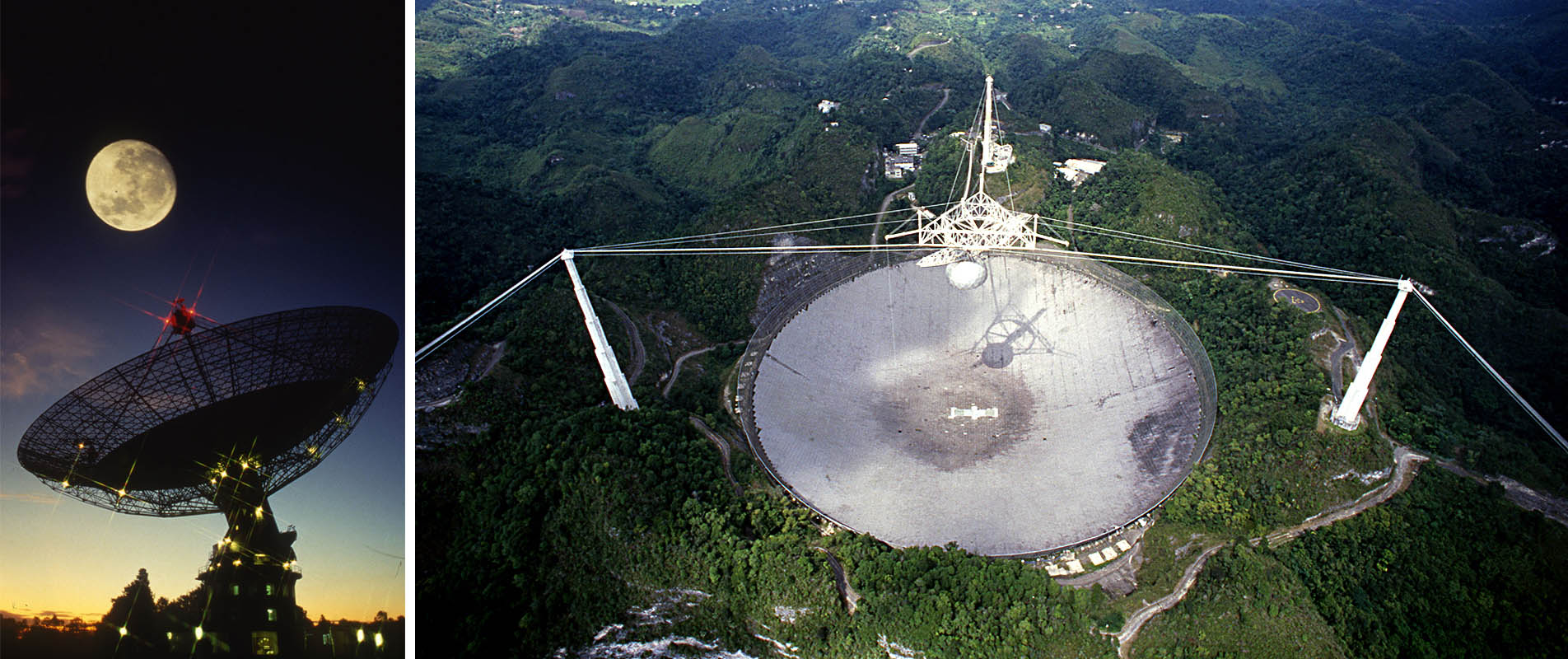
In the course of its approximately decade-long existence, Project Phoenix examined roughly 800 star systems within 200 light-years of Earth, and covered the radio dial between 1,200 and 3,000 MHz. While it failed to find any confirmed extraterrestrial signals, it remains one of the most extensive and sensitive of radio SETI endeavors.
Searches with the Allen Telescope Array
A multi-meeting workshop on the future of SETI research hosted by the SETI Institute at the end of the 1990s concluded that if the SETI enterprise was to significantly advance, it was necessary that the scientists involved have access to their own antenna, rather than competing with the radio astronomy community to use existing instruments.
This led to the design and construction of the Allen Telescope Array. By the turn of the millennium, advances in electronics made it far cheaper to build lots of small antennas than a very large one. Antenna arrays also have the advantage of being able to form many beams on the sky simultaneously. This means that more and potentially many more) targets can be observed in a given amount of time. Multibeam instruments are also able to easily distinguish between cosmic signals and interference caused by transmitters on Earth or by orbiting satellites.
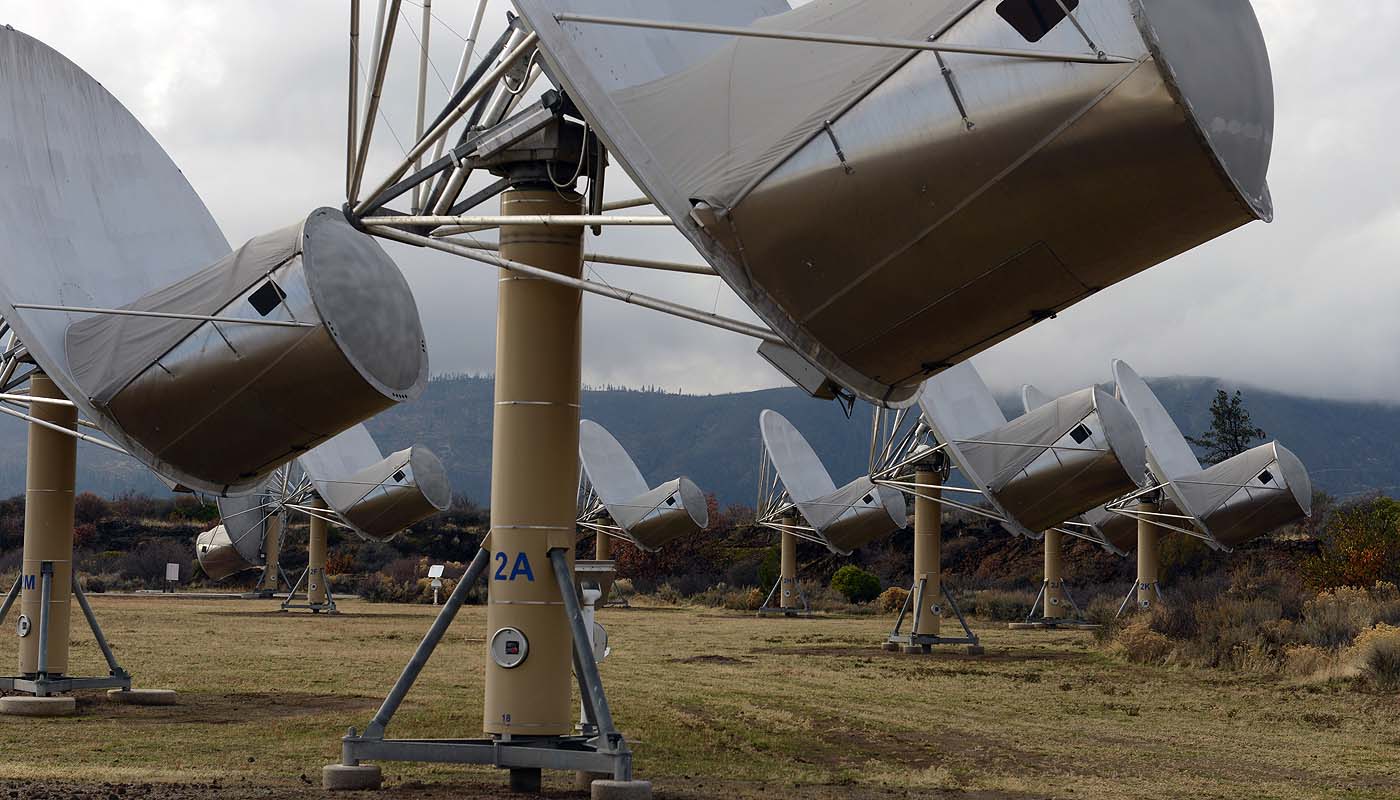
The Allen Telescope Array (ATA) was named after its principal supporter, Paul Allen, the co-founder of the Microsoft Corporation. While the intention was to build 350 small (6 meter diameter) antennas, the costs of engineering the instrument proved greater than anticipated, and the total number now stands at 42. The ATA is located at the Hat Creek Radio Observatory, in the California’s Cascade Mountains, approximately 300 miles north of San Francisco.
Currently, the ATA can form three simultaneous beams and can listen to 72 million 1 Hz radio channels simultaneously. Its tuning range is 1,000 to 14,000 MHz, and the Array is in the process of being outfitted with new, high-performance microwave receivers, designed by Berkeley radio astronomer Jack Welch, made possible with the personal financial support of Franklin Antonio, a co-founder of the telecommunications company Qualcomm.
The ATA has been used in several observing programs, including an extension of Project Phoenix in which it was trained at nearby (no more than a few hundred light-years) Sun-like stars. It has also been deployed in searching for signals originating near the Milky Way’s galactic center and from objects of special interest such as Tabby’s Star (KIC 8462852), TRAPPIST 1, the WOW signal (originally found at the Ohio State Observatory in 1977), and the (probable) comet, 'Oumuamua.
While the ATA is the principal instrument used by the SETI Institute for its searches, these observations will be supplemented by a “piggyback” system on New Mexico’s Very Large Array. The VLA setup will allow observations 24/7.
The organization is also developing an all-sky camera that, after deployment, will hunt for intermittent extraterrestrial laser flashes. This LaserSETI project is headed by Eliot Gillum.
Another Bay Area organization doing SETI research is the Breakthrough Listen group at the University of California, Berkeley. Information on this very extensive effort can be found elsewhere. Harvard University also has an ongoing SETI experiment looking for laser flashes.
Sensitivity of SETI Searches
What sort of transmissions could today’s SETI experiments find? Obviously, this depends on the aliens’ transmitter setup (be it either radio or lasers.)
Typical sensitivity of observations made with the Allen Telescope Array to narrow-band signal components is about 10 Janskys, or 10 x 10-26 watts/m2-Hz.
Translating that into more familiar terms, imagine an alien transmitter 50 light-years away (note that there are 5 – 10 thousand star systems lying within this distance). If this transmitter is affixed to an antenna as large as was the 1,000-foot diameter Arecibo instrument in Puerto Rico and is aimed our way, then the ATA could detect a narrow-band signal (1 Hz or less wide) if their transmitter power was 30 kilowatts or more. That’s scarcely a large number – there are beefier transmitters than this here on Earth.
However, this hypothetical setup depends on the alien antenna being aimed in our direction. If we assume that the extraterrestrials are not deliberately targeting our Solar System but simply aiming in all directions equally, then the minimum required power for a detectable signal is closer to 300 gigawatts. A transmitter of this strength would result in a substantial power bill for the aliens. Three hundred gigawatts is approximately one percent of the total power used by all humanity, and if we assume the aliens pay the same rate for electricity that we do on Earth, this would cost them about $300 million per hour.
But truly advanced civilizations might be expected to have access to far cheaper energy, much larger antenna arrays, and the capability to precisely target star systems. This could drastically reduce the power requirements to produce a transmission detectable by our SETI experiments, and even permit the aliens to target many different star systems.
Note that there are no existing antennas on Earth with adequate sensitivity to find alien television signals, assuming these are similar in power and antenna performance to our own. The farthest we might be able to pick up an alien TV broadcast is approximately 1 light-year, significantly less than the distance to even the nearest other star system.
Other Approaches
Some folks think that using radio or light to communicate between the stars is “old school.” Surely, many people argue, advanced aliens would use something better?
But what does “better” mean?
Both gravitational waves and neutrinos have been suggested as ways to convey information across space. Each of these offers the advantage that one need not build a telescope, but merely a detector. Both travel unhindered through the Earth, so signals from any direction would be detectable by an appropriate receiver.
However, gravitational waves are difficult to receive, to produce, and to modulate (i.e., the process of attaching a message). The ones detected so far are thought to be generated by colliding black holes and neutron stars, and these are obviously hard to arrange and control. Neutrinos are similarly unwieldly to produce and detect, although less so than gravitational waves. But they are highly energetic particles, so sending a “bit” of information via a neutrino beam is expensive.
It’s also worth pointing out that neither of these schemes results in faster communication. Both gravitational waves and neutrinos travel at or near the speed of light – the same as radio and laser beams.
There are people who think that the really “better” scheme would be to take advantage of the phenomenon of quantum entanglement – a physical effect that operates instantaneously. However, as physicists will tell you, quantum entanglement does not permit faster-than-light communication, despite what you may have heard.
Why hasn’t SETI picked up any alien signals?
Some people think that, after six decades of searching, the fact that SETI researchers have yet to pick up a signal from space might mean something. Perhaps the aliens don’t want to broadcast in our direction (maybe we’re not worthy!) Others believe that the apparent silence means that there are no intelligent beings out there, and humans are the smartest things in the galaxy, a circumstance that many readers might find comforting or possibly self-evident.
But there’s a more reasonable explanation for the fact that SETI receivers have so far heard nothing that’s clearly extraterrestrial. Namely, the experiments have simply not examined enough of the sky. Or perhaps our instruments don’t have enough sensitivity, or maybe they’ve not been tuned to the correct frequency. So, if you buy into any of these explanations – which maintain that we haven’t found any aliens simply because we haven’t tried hard enough – then our future strategy is obvious. We simply have to be patient and continue to press the search.
Said another way, we continue to assume that the trillion or so planets in the Milky Way house some transmitting societies, but our experiments have to continue and continue to improve in order to succeed in picking up a signal.
There are countless other explanations for the “great silence.” Some of these are sociological (the aliens don’t find us interesting or worthy) while others are paranoid (broadcasting into space is dangerous, so the aliens don’t do it). It’s also been suggested that some “great filter” operates on intelligent species, causing their destruction before they can reach a technological level that would allow them to get in touch. However, the real reason that SETI has yet to find any convincing signals might only become clear once we’ve detected something.
And If We Find Something?
In 2010, the SETI Permanent Committee of the International Academy of Astronautics revised a set of protocols to use in case of a SETI detection. You can find them here: http://www.setileague.org/iaaseti/protocols_rev2010.pdf
The protocols say three things:
- In case of the detection of a suspected extraterrestrial signal, take measures to confirm that it’s real.
- Make the discovery known – to everyone.
- Do not undertake transmitting a reply without first consulting the international community.
In fact, experience with false alarms has amply demonstrated that in case of a signal detection, the first thing that occurs is that the SETI community is inundated with a slew of inquiries from the media. This belies the common impression that a discovery would be kept under wraps. If a signal is found and confirmed, you will quickly learn of it.
-Seth Shostak, updated: July 2021.
